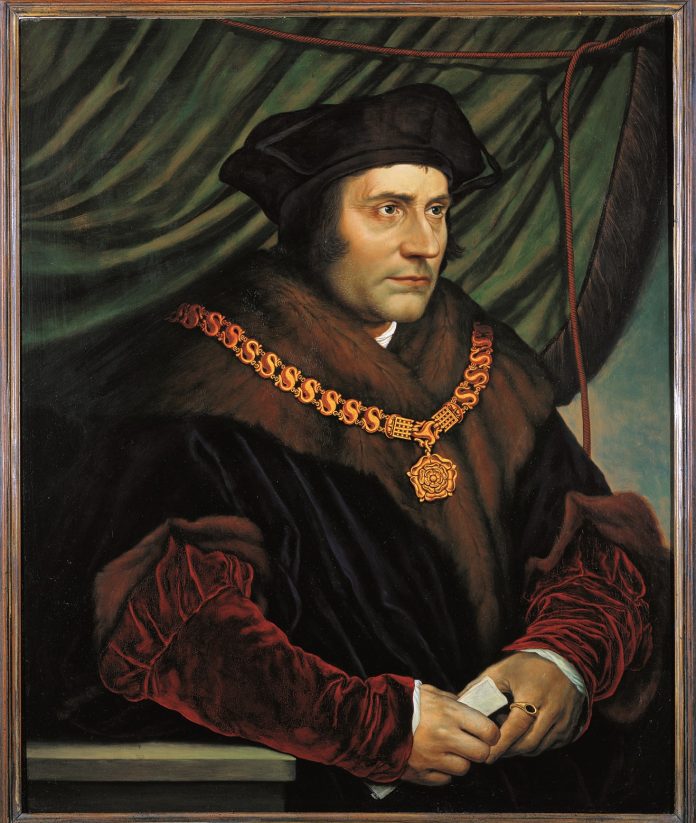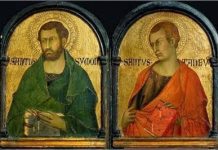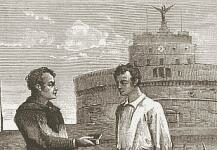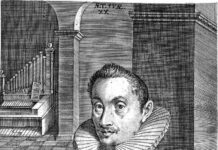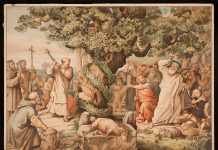As a prayerful and traditional Catholic, Tolkien had a profound devotion to many saints. Foremost, of course, was the Blessed Virgin Mary, upon whom, as he described, “all my own small perception of beauty both in majesty and simplicity is founded.”[1] Extending from his filial love for his spiritual Mother, Tolkien greatly venerated St. Bernadette Soubirous, the visionary of Our Lady of Lourdes, as well as St. John the Evangelist, to whom Christ commended His Mother on the Cross. As explored in a previous post, Tolkien’s patron saint was St. Philip Neri, whose spirituality of the Oratory, instilled into Tolkien by Fr. Francis Martin and the other Oratorian fathers of his childhood, greatly shaped Tolkien’s Catholicism throughout his life.
Alongside these heroic saints, however, is another who was particularly dear to Tolkien as an English Catholic and about whom he expressed some of his most heartfelt religious piety, a saint who was canonized in his own lifetime: St. Thomas More. Tolkien’s great friend, the Anglo-Catholic scholar R.W. Chambers, wrote an admirably objective and faithful account of More’s life, and Tolkien described the biography as “overwhelmingly moving” and “almost burningly topical.” He said that More himself “must approve with celestial pleasure.” Unlike Robert Bolt, who wrote the popular play about More entitled A Man for All Seasons and confessed that he was “treating Thomas More, a Christian saint, as a hero of selfhood”, Chambers recognized that More “died for the Papacy, ‘suffering death in and for the faith of the Holy Catholic Church.’”[2]
Though not a hyperpapalist, as shown by his willingness to critique the aims of the Second Vatican Council and the reforms of the Novus Ordo, Tolkien still recognized the truth and central importance of the papacy, stating,
I myself am convinced by the Petrine claims, nor looking around the world does there seem much doubt which (if Christianity is true) is the True Church, the temple of the Spirit dying but living, corrupt but holy, self-reforming and rearising. But for me that Church of which the Pope is the acknowledged head on earth has as chief claim that it is the one that has (and still does) ever defended the Blessed Sacrament, and given it most honour, and put it (as Christ plainly intended) in the prime place. ‘Feed my sheep’ was His last charge to St Peter; and since His words are always first to be understood literally, I suppose them to refer primarily to the Bread of Life. It was against this that the W. European revolt (or Reformation) was really launched – ‘the blasphemous fable of the Mass’ – and faith/works a mere red herring.[3]
For English Catholics since the time of the Reformation, when King Henry VIII wished to have his marriage to his legitimate wife, Catherine of Aragon, annulled, so that he might marry Anne Boleyn but, being denied by the pope, decided to proclaim himself ‘Head of the Church of England’. He subsequently required all Englishmen to pledge an oath recognizing him as such on pain of death, as loyalty to the pope was a powerful sign of their Catholic identity. None symbolized this spirit more than St. Thomas More, who was even willing to concede a reconsideration of Henry’s request for an annulment of his marriage, despite More’s personal friendship with Catherine, and, out of his equal friendship and duty to the king, hoped his simple silence on the question of supremacy in the Church would suffice, but was ultimately condemned to beheading after refusing to sign the oath.
Tolkien saw in this resistance to anti-Catholic political tyranny a heroic inspiration for his own time. More, who was canonized in 1935, just as communism, fascism and Nazism were coming to dominate large swaths of Europe and any Catholics who resisted their demonic agendas were violently persecuted, inspired Tolkien in his own fight for the Faith against these influences which were also prominent in his own country. Tolkien firmly brushed off the attempts by Nazis to recruit him, describing Hitler as “that ruddy little ignoramus” and “a vulgar and ignorant little cad” and Josef Stalin as “that bloodthirsty old murderer.”[4]
But alongside these more violent attacks, Tolkien also endured many acts of anti-Catholic bigotry from his fellow Englishmen, not only those of his and Edith’s Protestant relatives but also the slur of “Papist” from C.S. Lewis[5] and others close to him, as well as the prejudice of fellow Oxford dons, including one instance when a Master said, commenting on the recent election to the Rectorship of Lincoln, “Thank heaven they did not elect a Roman Catholic to the Rectorship anyway: disastrous, disastrous for the college,” as he sat next to Tolkien.[6] Nevertheless, while Tolkien considered himself “convinced of the Petrine claims” and endured some forms of persecution for his faith, the heroic witness (μάρτυς) of St. Thomas More was a stark reminder of the great sacrifice that might be demanded of Tolkien – and of any Catholic – in an increasingly anti-Catholic world.
More and Tolkien shared many things in common. Both were family men, lovingly devoted to their wives and children, supporting the latter, including the girls, in their education and handing on to them their Catholic faith as good fathers should. Both also had to endure the falling away of their children from the Faith, with More’s whole family signing the oath of supremacy and only two of Tolkien’s children remaining Catholic while his wife Edith also struggled with her conversion throughout her life. Both were learned humanists, schooled in the classics of Greek and Latin and familiar with the saints of the patristic and medieval periods. Both were fiction writers, including fantasy (Tolkien’s Middle-earth legendarium and More’s Utopia) and other stories (e.g. Tolkien’s Leaf by Niggle and More’s many dialectic narratives, including A Dialogue Concerning Heresies). And, despite the hardships they endured from it, both were in love with their homeland of England and loyal to the monarch, with Tolkien even receiving a CBE from Queen Elizabeth II a year before his death.
Like Tolkien, much of More’s character, and the great affinity between the two saintly men, can be gleaned from his fictional writings. In a beautiful testament reflecting their shared love of learning, More wrote in A Dialogue Concerning Heresies,
[R]eason is by study, labour, and exercise of logic, philosophy and other… liberal arts corroborate and quickened, and that judgment both in them, and also in orators, laws and stories, much riped. And albeit poets be with many men taken but for painted words, yet do they much help the judgment, and make a man among other things well furnished of one special thing, without which all learning is half lame… a good mother wit.[7]
This goes far beyond the pragmatic Enlightenment/Marxist theory of education as mere job training and ideological brainwashing which predominates today, instead echoing the classical view of education as that which “leads out of” (educare) and “frees” (libera) from ignorance and trains the intellect and will in virtue. Tolkien similarly wrote:
I had once a considerable experience of what are/were probably England’s most (at least apparently) dullest and stodgiest students: Yorkshire’s young men and women of sub-public school class and home backgrounds bookless and cultureless. That does not, however, necessarily indicate the actual innate mental capacity – largely unawakened – of any given individual. A surprisingly large proportion prove ‘educable’: for which a primary qualification is the willingness to do some work (to learn) (at any level of intelligence). Teaching is a most exhausting task. But I would rather spend myself on removing the ‘dull’ from ‘stodges’ – providing some products of β to β + quality that retain some sanity – a hopeful soil from which another generation with some higher intelligence could arise. Rather – rather than waste effort on those of (apparently at any rate) higher intelligence that have been corrupted and disintegrated by school, and the ‘climate’ of our present days.[8]
One of the most marked differences between Catholics and Protestants is the Catholic use of a crucifix, on which the corpus of Christ is exhibited in all its victorious tragedy, sometimes even with an arresting emphasis on His horrific torture at the hands of sinners. Tolkien and St. Thomas More shared an appreciation for the purgatorial role of redemptive suffering. As More once explained to his children, “We may not look at our pleasure to go to heaven in feather beds, it is not the way. For our Lord himself went thither with great pain, and by many tribulations, which is the path wherein he walked thither, and the servant may not look to be in better case than his Master.”[9] Tolkien, also fond of giving fatherly advice, similarly counselled his son Michael, “the essence of a fallen world is that the best cannot be attained by free enjoyment, or by what is called ‘self-realization’ (usually a nice name for self-indulgence, wholly inimical to the realization of other selves); but by denial, by suffering.”[10]
This almost exactly echoes More’s proverbial statement in his A Dialogue of Comfort Against Tribulation (written during his long imprisonment in the Tower of London):
Every tribulation that we fall in, either cometh by our own known deserving deed bringing us to it, as the sickness that followeth our intemperate surfeit or the imprisonment or other punishment put upon a man for his heinous crime; or else it is sent us by God without any certain deserving cause open and known to ourselves, either for punishment of some sins past (we know not certainly which) or for preserving us from sin in which we would otherwise be like to fall; or finally it is not due to the man’s sin at all but is for the proof of his patience and increase of his merit. In all the former cases tribulation is, if we will, medicinable. In this last case of all, it is better than medicinable.[11]
And against the spirit of “self-realization” which Tolkien criticized and which is so prominent in our modern hyper-psychologized world, More wrote in The Treatise Upon the Passion, “I will simply counsel every man and woman to beware of even the very least speck of [pride], which seems to me to be the mere delight and liking of ourselves for anything whatsoever that either is in us or outwardly belongs to us.”[12]
Some people who look back on More’s handling of the situation with Henry VIII’s break from Rome could accuse him of reacting too softly or indirectly, choosing to remain largely silent and address the issues and those involved in them through subtle references in his writings. But this reservation was not indicative of a timid or cowardly spirit, as his ferocity in combating the errors of Protestantism proves; it is more so a sign of his deep humility and cultured desire for free, rational dialogue, a desire which he was not granted. Tolkien shared this trait, usually remaining silent or restrained when confronting the anti-Catholic bias of those around him but never failing to uphold the truth and correct errors when he saw them while still retaining a spirit of charity. Tolkien always tried to keep in mind a principle which St. Thomas More exemplified:
It is one of the mysteries of pain that it is, for the sufferer, an opportunity for good, a path of ascent however hard. But it remains an ‘evil’, and it must dismay any conscience to have caused it carelessly, or in excess, let alone wilfully. And even under necessity or privilege, as of a father or master in punishment, or even of a man beating a dog, it is the rod of God only to be wielded with trepidation.[13]
Though some could find certain precedents to them, it can be said that both Tolkien and St. Thomas More invented or at least popularized two new genres of literature: high fantasy for the former and utopianism for the latter. And, in both instances, their critics and fans ever since have generally misunderstood the deeper meaning within their works, primarily due to their non-Catholic ignorance or anti-Catholic bias. More’s Utopia has been understood by most as though he agreed with Raphael, the character who espouses a utopian (meaning “no-place” in Greek, i.e. a place that is unnatural and unrealizable) philosophy of communism and liberal Christianity, rather than his interlocutor Morus, who was likely based on More himself and upheld the truth of perennial philosophy and traditional Christian orthodoxy.
In this way, Raphael and his utopian city are intended by More as a satire of the society and ideas of his time, including certain social injustices whose criticism are one point of agreement between More and Raphael, but also the denial of private property which would characterize certain radical Protestant elements, particularly Anabaptists, in the following century and Marxists later on, as well as Raphael’s Gnostic occultism which was popular in Renaissance Europe and his revolutionary/anarchist denigration of the Ciceronian civic virtue championed by Morus.
Ultimately, and contrary to modern critics, More’s Utopia is not a proto-Marxist or Nietzschean power-play or a psychological roleplay of More’s repressed desires. Rather, it reflects his Catholic humanist values. Taking the form of a Socratic dialogue, it shows the beliefs of its characters not only through their dialectic but also their way of life, as Gerard Wegemer explains:
Morus embodies the civic traits advocated by Cicero and articulates the philosophy of Christian humanism that was prevalent in late medieval and Renaissance Europe, while Raphael identifies himself with an apolitical philosophy that condemns Ciceronian diplomacy and moderate reform as unjust and wholly ineffective. Raphael, in fact, represents an amalgam of the Stoic and Epicurean elements which Cicero considered the greatest dangers of political life.
More’s literary classic is also based on the style of the ancient Roman writer Lucian, especially, according to Wegemer, the way “whereby More distances himself from his characters the same way Lucian does in his dialogues” and “the lighter side of the Lucianic humor satirizing various features of that regime [in the Utopia] and its defender [Raphael].” This is another element shared by More and Tolkien: a keen sense of humor.
Wegemer additionally identifies one of the central influences on Utopia which is also key to understanding St. Thomas More’s Catholicism: St. Augustine’s City of God, on which More lectured. Wegemer delineates the intentional contrasts between them:
Utopia boasts of a 1760-year history in which no civil wars have taken place and only two natural catastrophes have affected their civic life; the City of God teaches that constant war and continuous catastrophes both natural and moral will always plague human societies. Utopia claims to be ‘not only the best but the only [political order] which can rightly claim the name of a commonwealth’; the City of God denies that a truly just commonwealth is possible anywhere or at any time here on earth. The City of God considers ‘nothing more disgraceful and monstrous’ than holding pleasure as the end of life—the very position held by the Utopians. The City of God is indifferent to customs if these do not directly violate the law of God; Utopia is absolutely unbending in social custom, even in such matters as arbitrary as dress or choice of home.[14]
Unfortunately, as with the “fundamentally religious and Catholic” themes in The Lord of the Rings, which are “absorbed into the story and the symbolism”,[15] More’s deeper themes in Utopia are generally missed. Even so, as masterpieces of Catholic fiction both have the power to draw readers closer to Christ. Tolkien and More can thus be seen as kindred spirits, separated by centuries yet close in heart. Now, these saintly men wait to intercede together for the Church Militant with their prayers in Heaven, if we will only ask.
[1] J.R.R. Tolkien; Humphrey Carpenter and Christopher Tolkien (eds), The Letters of J.R.R. Tolkien (New York: Houghton Mifflin, 2000), letter 142.
[2] See Holly Ordway, Tolkien’s Faith (Elk Grove Village, IL: Word on Fire Academic, 2023), 204-206.
[3] Tolkien, Letters, letter 250.
[4] Tolkien, Letters, letters 45, 81, 53.
[5] Colin Duriez, J.R.R. Tolkien: The Making of a Legend (Oxford, England: Lion Books, 2012), 154.
[6] Tolkien, Letters, letter 72.
[7] Thomas More, “A Dialogue Concerning Heresies,” in Delphi Collected Works of Sir Thomas More (2018), 620-621. Kindle.
[8] Tolkien, Letters, letter 314.
[9] Thomas More, “The Life of Sir Thomas More by William Roper,” in Delphi Collected Works of Sir Thomas More (2018), 2138. Kindle.
[10] Tolkien, Letters, letter 43.
[11]Thomas More, “A Dialogue of Comfort against Tribulation,” in Delphi Collected Works of Sir Thomas More (2018), 1220. Kindle.
[12] See Thomas More, Treatise Upon the Passions, quoted at Thomas More Studies, https://thomasmorestudies.org/quotes/.
[13] Tolkien, Letters, letter 113.
[14] Gerard Wegemer, “The ‘Utopia’ of Thomas More: A Contemporary Battleground,” at The Imaginative Conservative (2017), www.theimaginativeconservative.org.
[15] Tolkien, Letters, letter 142.

